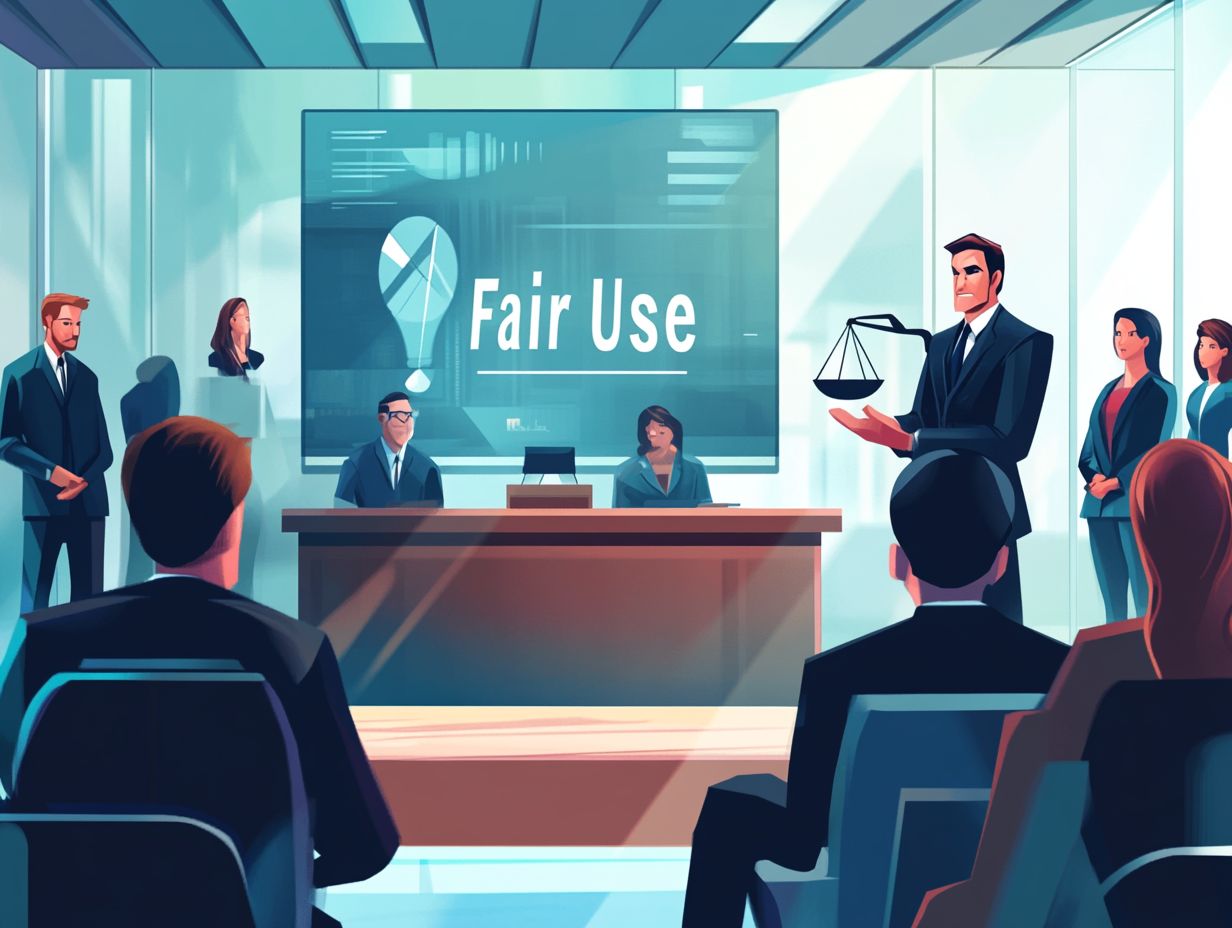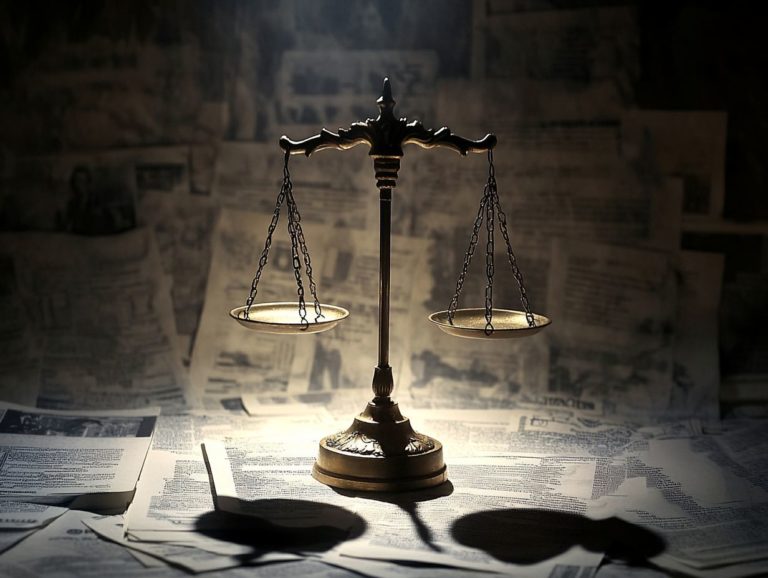Understanding the Term ‘Fair Use’ in IP Litigation
Understanding the complex world of intellectual property can be quite the challenge, particularly when it comes to grasping the concept of Fair Use.
This crucial doctrine permits limited use of copyrighted material without needing permission, yet its application is far from straightforward.
Get ready to discover the definition and history of Fair Use. Explore landmark legal cases that have shaped its interpretation, and break down the essential factors that determine Fair Use in real-world contexts.
You ll also learn effective strategies for defending Fair Use in litigation, gaining insights that empower creators, legal professionals, and anyone keen on safeguarding their intellectual property rights.
Contents
- Key Takeaways:
- What is Fair Use?
- History of Fair Use in IP Litigation
- Factors Considered in Determining Fair Use
- Defending Fair Use in IP Litigation
- Frequently Asked Questions
- What is the definition of fair use in IP litigation?
- What factors are considered when determining fair use in IP litigation?
- What is the purpose and character of the use in fair use?
- What is the nature of the copyrighted work in fair use?
- How does the amount and substantiality of the portion used impact fair use?
- What is the effect of the use on the potential market for the copyrighted work in fair use?
Key Takeaways:

Fair Use is a legal doctrine that allows for the limited use of copyrighted material without permission from the owner. Key factors in determining Fair Use include the purpose and character of use, nature of the work, amount used, and effect on market value. In IP litigation, defending Fair Use can involve strategic arguments and referencing relevant legal precedents.
What is Fair Use?
Fair Use is an essential legal principle within copyright law that grants you the ability to use copyrighted material without obtaining permission from the copyright owner, but only within certain limits.
This doctrine is vital for striking a balance between the rights of creators and the interests of the public. It allows for transformative uses, like commentary, criticism, and nonprofit educational endeavors.
By grasping the intricacies of Fair Use, you can skillfully navigate copyright protections and leverage creative works in ways that are legally sound.
Defining the Concept
The concept of Fair Use is a cornerstone of copyright law. It provides you with the flexibility to utilize copyrighted material. This principle originated from early legislative efforts designed to protect creators while also recognizing the public’s right to access and comment on existing works.
The historical roots trace back to the 1976 Copyright Act, which aimed to strike a balance between safeguarding intellectual property rights and nurturing creativity through transformative use.
In today s fast-paced digital landscape, where content spreads rapidly across various platforms, Fair Use takes on even greater importance.
It gives you the power whether as a creator, educator, or user to engage with and recontextualize copyrighted works without the fear of legal repercussions, all while ensuring that original creators receive the recognition they rightfully deserve for their contributions.
History of Fair Use in IP Litigation
The history of Fair Use in intellectual property litigation unfolds as a complex narrative. It is intricately shaped by pivotal case law and judicial decisions that have continually redefined the boundaries of copyright protections throughout the years.
Key Cases and Legal Precedents

Several key cases have profoundly influenced the legal landscape surrounding Fair Use in copyright law. The landmark Campbell case began when a popular rap group crafted a parody of a well-known song. This sparked a crucial examination of the delicate balance between the rights of copyright holders and the significance of creative expression.
The court ultimately sided with the rap group, establishing that transformative use could frequently qualify for Fair Use protections. This decision highlighted critical factors such as the purpose behind the use and its impact on the market for the original work.
In the wake of this ruling, subsequent cases have continued to delve into these principles, providing essential guidance for artists and creators as they navigate the intricate world of copyright law and Fair Use.
Factors Considered in Determining Fair Use
Determining Fair Use requires you to carefully analyze four crucial factors.
First, consider the purpose and character of your use whether it’s transformative or commercial. Next, assess the nature of the copyrighted work itself.
Then, evaluate the amount and substantiality of the portion you’re using. Finally, reflect on how your use could impact the potential market value of the original work.
Together, these factors inform the legal analysis under copyright law, guiding you toward an informed decision.
As you apply your newfound understanding of Fair Use, consider how it can benefit your creative projects. Don’t hesitate to seek legal advice if you’re unsure about any specific use.
Purpose and Character of Use
The purpose and character of your use is the first factor in determining Fair Use, which allows limited use of copyrighted material without permission. It focuses on whether your actions are transformative, educational, or serve as commentary and criticism.
This element helps you distinguish between allowed and infringing uses. For example, using copyrighted material in an educational setting like in a classroom or online course can significantly impact the Fair Use assessment.
If you alter the material to create new insights or promote critical thinking, it may be considered transformative and work in your favor during analysis.
Commentary and criticism often involve incorporating copyrighted works to support your arguments or viewpoints. This emphasizes the importance of these uses in fostering discourse and advancing knowledge. Grasping these nuances is vital for your success as you navigate the complex area of copyright law.
Nature of the Copyrighted Work
The second factor to consider is the nature of the copyrighted work, which examines whether the work is published or unpublished and its creative versus factual characteristics. This distinction can significantly influence Fair Use determinations.
When a work is unpublished, courts tend to grant it greater protection. The creator hasn’t shared it with the public, highlighting the importance of respecting their intent and exclusivity.
For instance, using excerpts from an unpublished manuscript might not meet the criteria for Fair Use, while citing a published research article could be viewed differently especially if it serves a transformative purpose. Factual works often provide more flexibility in Fair Use claims compared to highly creative pieces, like novels or songs.
In those cases, the original expression carries more weight in the evaluation, making it essential to tread carefully.
Amount and Substantiality of the Portion Used

The third factor in the Fair Use analysis examines the amount and substantiality of the portion you use in relation to the original work. It evaluates whether the quantity and significance of what you ve taken affect the overall assessment.
This evaluation can significantly influence legal outcomes, as courts often scrutinize the specific segments that have been appropriated. For example, using a brief quote from a book in a critical review is likely to be perceived quite differently than including an entire chapter in a compilation.
If a filmmaker incorporates a substantial clip from a movie for commentary, it raises important questions about the purpose behind the usage. Thus, the extent of the original work you incorporate along with its role in the new context is crucial in determining whether your usage qualifies as Fair Use.
Effect on Potential Market or Value
The final factor assesses how your use may impact the potential market or value of the original work. This is crucial in determining whether your actions could harm the market for the copyrighted material.
This aspect of Fair Use is fundamental, as it influences judicial decisions and underscores the delicate balance between creativity and copyright protection.
Take, for instance, the landmark case of Harper & Row v. Nation Enterprises, where the court highlighted that unauthorized use of excerpts from a president’s unpublished memoir affected the market for the complete work. Similarly, in Campbell v. Acuff-Rose Music, the Supreme Court recognized that a parody might divert audiences from the original song, thereby impacting its commercial value.
These examples illustrate how perceived market harm or the absence of it plays a pivotal role in Fair Use determinations. It s crucial to understand this now to avoid costly mistakes later as you navigate the landscape of using existing works while respecting the original intellectual property.
Defending Fair Use in IP Litigation
Defending Fair Use in intellectual property litigation demands a comprehensive grasp of copyright law. It often requires you to seek legal advice or consult with an attorney to effectively navigate the complex defenses against infringement.
Strategies and Arguments
When defending Fair Use, craft your strategies to match the specific details of each case. Copyright law varies by situation.
The context of the work’s use, the purpose behind it, and how much of the original work is used are key factors. These can greatly influence a court’s decision.
For example, educational institutions often argue that using a small part of a copyrighted text in class serves a transformative purpose. This strengthens their Fair Use defense.
In the landmark case of Campbell v. Acuff-Rose Music, the Supreme Court showed that parody can qualify as Fair Use. They stressed the need to evaluate how much of the original work is used compared to the new work’s purpose.
These examples highlight how surrounding circumstances can dramatically affect the outcome of legal cases. Legal defenders must analyze each case thoroughly.
Frequently Asked Questions

What is the definition of fair use in IP litigation?
Fair use is a legal rule that allows limited use of copyrighted material without permission. It promotes creativity while balancing the rights of copyright holders.
What factors are considered when determining fair use in IP litigation?
Four factors determine fair use: purpose and character of use, nature of the copyrighted work, amount used, and the effect on the market for the original work.
What is the purpose and character of the use in fair use?
The purpose refers to how the copyrighted material is used. Using it for educational or non-profit reasons is more likely to be fair use than using it for profit.
What is the nature of the copyrighted work in fair use?
The nature refers to the type of work being used. Creative works, like novels or films, receive more protection than factual works, such as news articles.
How does the amount and substantiality of the portion used impact fair use?
This factor looks at how much and how important the used material is. Small portions used in a transformative way are more likely to be fair use than large portions used unchanged.
What is the effect of the use on the potential market for the copyrighted work in fair use?
This refers to how the use might affect the market for the original work. If the use doesn t harm the market, it s more likely to be considered fair use.






